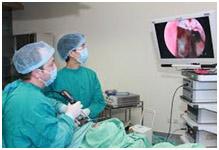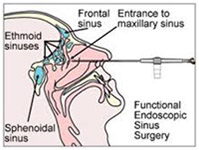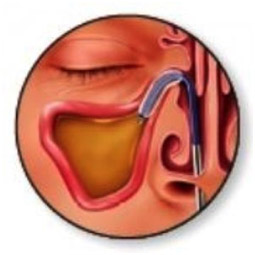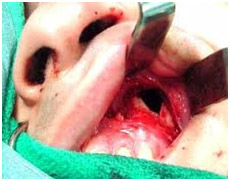Functional Endoscopic Sinus Surgery ( FESS) & Balloon Sinuplasty
In adults, the maxillary sinuses are most commonly affected with acute and chronic sinusitis. Most of these cases can be managed with medications alone. When medical management fails, surgery may be needed to treat chronic maxillary sinusitis.
History of surgical therapy for chronic maxillary sinusitis
Open approaches to the maxillary sinus were first described in the early 1700s. The well-known Caldwell-Luc operation was first described in the United States by George Walter Caldwell in 1893 and then by Henri Luc of France in 1897. Subsequent advances in the understanding of the physiologic drainage pattern of the maxillary sinus led to intranasal middle meatus antrostomy in the late 1960s and the early 1970s.
Functional endoscopic sinus surgery (FESS) is based on the surgical approach performed by Messerklinger and Wigand in Europe via the ostiomeatal complex. FESS has become the standard surgical treatment for chronic maxillary sinusitis, with external approaches being used as an adjunct in more complicated cases or in tumor management., the maxillary sinuses are most commonly affected with acute and chronic sinusitis. Most of these cases can be managed with medications alone. When medical management fails, surgery may be needed.
Functional endoscopic surgery is a minimal invasive technique.The surgery is done under direct vision. The goal is to restore sinus ventilation and the normal function of the nose.
With the introduction of this new technique of endoscopic sinus surgery the success rate hasimsrr the sketch belowproved to about 85-90 %. The improvement is mainly due to the ability to visualize the difficult hidden anatomical areas in the lateral wall of the nose. One of the big factor responsible for the failure was the improper site selection for the intra nasal antrostomies (an opening or creating a hole , here in the hollow bone of the maxillary sinus is made to allow the drainage of the sinus secretions in to the nose). The antrostomies were done in the inferior meatus. This problem has been solved by the advance technique of making the natural ostium of the maxillary sinuses bigger in the middle meatus, thus maintaining the normal anatomical site. With conventional instruments it is not possible to see them and it required special instruments and thanks God the angular vision by the endoscopes which made it possible to see the corners and the hidden areas in the small groves.
The endoscopic sinus surgery usually combined with the nasal surgery to improve the functions of the nose and is known as FESS. i.e. Functional endoscopic sinus surgery . Now the use of laser as it provides aprecise cutting, excellent hemostasis, minimal lateral tissue reaction. The result is no or minimal bleeding, minimal pain, minimal sewing, no scar and the recovery is much quicker.
Balloon Sinuplasty
This is an advance technique in which the sinus infection in selected cases is cleared by means of a balloon , in which there is no cut or incision. This method is like the angioplasty where the narrow blood vessel is stretched by inflating a balloon under vision and a stent is applied to prevent the collapsing of the stretched blood vessel. In case of sinuses the opening is dilated by the soft balloon under the vision of the endoscopic camera. After dilatation of the sinus opening there is no need for the stent as the walls of the sinus opening have delicate bones and these bones are out fractured due to the stretching by the soft balloon.
See the sketch below:
Previously and still nowadays at some centers the surgical treatment of chronic sinusitis is by the conventional approach of CaldWelLucs . In this approach a n opening is made in the maxillary sinus by giving an incision under the cheek and an opening is made in the bone so that the maxillary sinus could be exposed and the disease cleaned.
See the sketch below:




